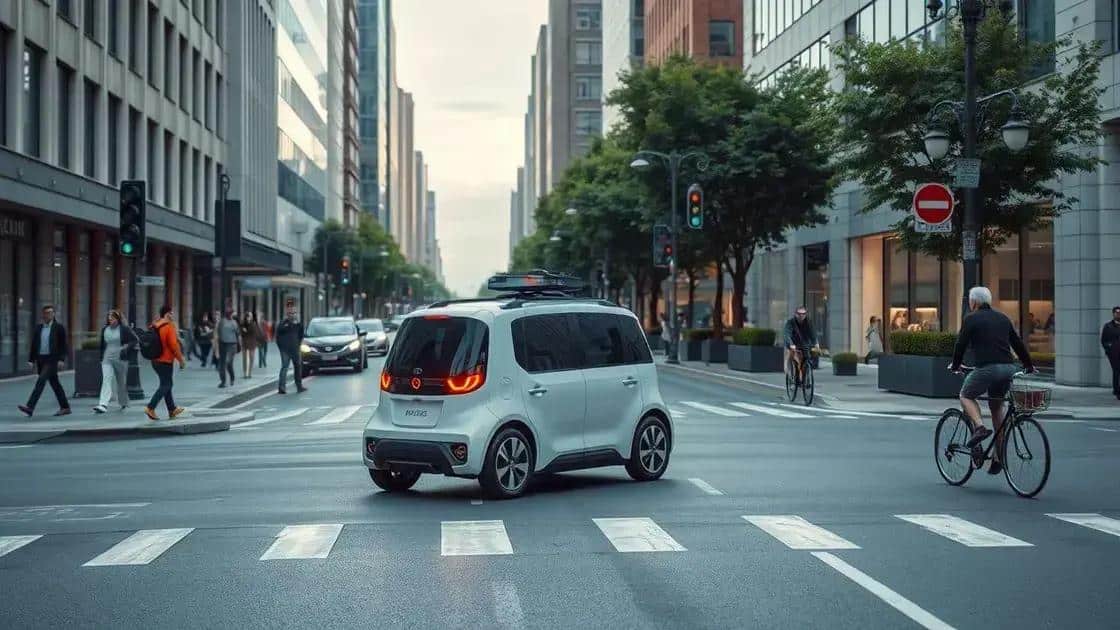Advancements in autonomous vehicle technology reshape transportation

Advancements in autonomous vehicle technology improve safety, reduce traffic congestion, and promote sustainable urban planning, reshaping transportation for the future.
Advancements in autonomous vehicle technology are not just technical marvels; they have the potential to transform our daily commute and redefine transportation. Have you considered how self-driving cars might change your life?
Understanding autonomous vehicle technology
Understanding autonomous vehicle technology is crucial as it shapes the future of transportation. These vehicles, equipped with advanced sensors and algorithms, are designed to navigate without human intervention. They are revolutionizing how we approach mobility, safety, and convenience.
One of the key components of autonomous vehicles is their reliance on artificial intelligence. This technology enables them to process vast amounts of information from their surroundings quickly. With real-time data analysis, autonomous vehicles can detect obstacles, interpret traffic signals, and make critical decisions.
Core Technologies Behind Autonomous Vehicles
Several technologies work in harmony to enable driverless operation. These include:
- LiDAR: Light Detection and Ranging technology that creates detailed 3D maps of the vehicle’s environment.
- Radar: Helps detect objects at long distances, even in adverse weather conditions.
- Cameras: Provide visual recognition capabilities to identify road signs, lane markings, and pedestrians.
Moreover, the interaction of these technologies allows the vehicle to have a comprehensive understanding of its surroundings. Each component contributes uniquely to decision-making processes. For instance, while LiDAR gives high-definition mapping, cameras offer visual cues.
The Role of Machine Learning
Machine learning plays a vital role in refining the performance of autonomous vehicles. As these vehicles collect data, they continually learn from their experiences. This ongoing process enables them to improve their decision-making over time.
Imagine a vehicle that learns the most efficient routes or the best ways to navigate traffic. This adaptability not only enhances safety but also makes driving more efficient.
In conclusion, understanding autonomous vehicle technology involves recognizing the synergy between various technologies. Their integration is reshaping the transportation landscape, making our roads safer and more efficient. As developments continue, we can expect even more remarkable advancements.
Key benefits of autonomous vehicles
There are many key benefits of autonomous vehicles that bring excitement and hope for the future. These vehicles promise to change how we travel and improve our lives in various ways.
One major advantage is enhanced safety. Autonomous vehicles are equipped with technology that allows them to react faster than human drivers. They can help reduce the number of accidents caused by human error, which accounts for a significant portion of road incidents.
Convenience and Accessibility
A second benefit is the convenience they offer. Imagine relaxing or working while your vehicle drives you to your destination. This possibility makes travel less stressful, especially in heavy traffic.
- Increased mobility: Autonomous vehicles can help people with disabilities or the elderly who may have trouble driving.
- 24/7 availability: They can operate at any time, allowing users to travel whenever they need.
- Shared transportation: These vehicles can be used in ride-sharing services, reducing the number of cars on the road.
Another important aspect is efficiency. Autonomous vehicles can optimize travel routes based on real-time traffic data. This leads to shorter travel times and reduced fuel consumption. By avoiding congested areas, these cars help decrease overall pollution.
Cost Savings
Over time, using autonomous vehicles may also lead to cost savings. With fewer accidents, insurance rates could drop. These vehicles may also reduce the need for personal car ownership, as ride-sharing becomes more common.
In addition, autonomous vehicles can lower operating costs for businesses. Logistics companies can utilize them for deliveries, increasing efficiency and cutting expenses.
Ultimately, the key benefits of autonomous vehicles include improved safety, greater convenience, increased efficiency, and potential cost savings. The promise of these advancements makes them an exciting area for future development.
Challenges in implementing autonomous vehicle systems

Implementing autonomous vehicle systems comes with several challenges that can impact their effectiveness and safety. These hurdles must be addressed to fully unlock the potential of this technology.
One major challenge is regulatory hurdles. Governments need to create new laws and standards for self-driving cars. This process can be slow, and inconsistency across regions complicates the implementation of autonomous vehicles.
Technical Challenges
Another critical aspect is the technical challenges in developing reliable infrastructure. Autonomous vehicles depend on high-quality data and communication systems to work effectively. Transport networks must be equipped with the necessary technology, such as road sensors and communication devices.
- Data security: Protecting the data collected by autonomous vehicles is essential to prevent hacking and misuse.
- Sensor accuracy: Ensuring sensors work well in various weather conditions is vital for safe driving.
- Software reliability: The software running autonomous systems must be tested thoroughly to avoid errors.
Human factors also play a significant role in the adoption of autonomous vehicles. Acceptance varies among drivers and passengers. Many people remain skeptical about self-driving cars’ safety and reliability. Educating the public and promoting trust is essential for wider acceptance.
Ethical Considerations
Ethical considerations pose another challenge. Deciding how an autonomous vehicle should react in accident scenarios raises complex questions. Manufacturers must determine acceptable algorithms for decision-making, which can significantly influence public opinion.
Moreover, there is the challenge of addressing insurance implications. New policies will need to be developed to cover accidents involving autonomous vehicles. This further complicates the process of integrating autonomous technology into society.
Overall, the challenges in implementing autonomous vehicle systems include regulatory issues, technical limitations, public acceptance, ethical dilemmas, and insurance considerations. Overcoming these obstacles is crucial for ensuring the safe and effective use of autonomous vehicles in the future.
Future trends in autonomous vehicle development
Future trends in autonomous vehicle development are promising and exciting. As technology continues to evolve, we are likely to see numerous advancements that will change transportation.
One significant trend is the integration of artificial intelligence to make vehicles smarter. These systems will learn from real-world driving experiences, adapting to different conditions and improving safety over time.
Enhanced Sensor Technology
Another area of development is enhanced sensor technology. Future autonomous vehicles will utilize advanced sensors to provide better environmental awareness. This can lead to:
- Improved navigation: With better sensors, vehicles can accurately detect obstacles in real time.
- Greater accuracy: High-definition maps combined with powerful sensors will allow for precise navigation within complicated environments.
- All-weather functionality: Future sensors will operate effectively in various weather conditions, such as rain, fog, or snow.
Moreover, electric autonomous vehicles are expected to become more common. As the world shifts towards sustainability, electric powertrains will work in tandem with autonomous technologies to reduce carbon emissions. This green initiative is important for the future of urban transport.
Connectivity and Vehicle-to-Everything (V2X)
In addition, vehicle-to-everything (V2X) connectivity will play a fundamental role. This technology allows vehicles to communicate with each other and with infrastructure. Benefits of V2X include:
- Improved traffic management: Vehicles can share real-time information on traffic conditions, optimizing travel routes.
- Enhanced safety measures: Cars can warn each other of potential hazards, helping prevent accidents.
- User customization: Drivers may receive personalized services based on their driving habits.
As urban areas grow, smart city integration will also drive future trends. Cities will adapt their infrastructures to support autonomous vehicles, leading to efficient traffic flows and reduced congestion.
In summary, the future of autonomous vehicle development is characterized by advancements in AI, enhanced sensors, electric vehicle adoption, V2X connectivity, and smart city integration. These trends will shape the way we move in the coming years.
The impact of autonomous vehicles on urban planning
The impact of autonomous vehicles on urban planning is significant and multifaceted. As self-driving cars become more prevalent, cities will need to adapt how they are designed and operated. Understanding these changes is vital for future urban development.
One major effect is the potential to reduce traffic congestion. With autonomous vehicles communicating with each other, they can optimize traffic flow. This leads to fewer traffic jams and shorter travel times, changing how streets and roadways are planned.
Redesigning Infrastructure
As cities adapt to the rise of autonomous vehicles, infrastructure will need redesigning. Street layouts may shift to accommodating self-driving cars better. More emphasis will be placed on:
- Dedicated lanes: Creating specific lanes for autonomous vehicles to improve safety and efficiency.
- Smart traffic signals: Implementing signals that can communicate with vehicles to enhance traffic management.
- Parking solutions: Redesigning parking spaces to streamline drop-off and pick-up areas as vehicles will need less parking time.
The need for parking will decline as autonomous vehicles can drop off passengers and park themselves elsewhere. This reduction allows cities to reclaim valuable land currently used for parking lots, which can be transformed into parks, housing, or commercial spaces.
Promoting Sustainability
Additionally, autonomous vehicles can support sustainability efforts. By integrating electric self-driving cars, cities can reduce their carbon footprints. Improved vehicle efficiency can often lead to lower emissions, making urban areas cleaner and healthier.
Moreover, with fewer cars on the road due to shared autonomous vehicle services, cities could see a decrease in pollution levels. This shift can encourage more green spaces and enhance the quality of life for residents.
In summary, the impact of autonomous vehicles on urban planning involves changes in infrastructure design, traffic management, parking needs, and sustainable development. These innovations position cities for a more efficient and environmentally friendly future.
In conclusion, the rise of autonomous vehicles holds great promise for reshaping transportation and urban living. These vehicles can lead to safer roads, less traffic, and a cleaner environment. As cities adapt, infrastructure will improve, making spaces more efficient and enjoyable for everyone. The integration of smart technology will bring significant changes to how we navigate our daily lives. Embracing these advancements will be crucial for creating greener and more accessible urban areas.
FAQ – Frequently Asked Questions about Autonomous Vehicles
What are the main benefits of autonomous vehicles?
Autonomous vehicles enhance safety, reduce traffic congestion, promote sustainability, and increase accessibility for all.
How will urban planning change with the rise of autonomous vehicles?
Cities will adapt by redesigning infrastructure to accommodate self-driving cars, optimizing traffic flow, and reclaiming parking spaces for green areas.
What role does technology play in autonomous vehicles?
Advanced sensors, artificial intelligence, and connectivity features enable autonomous vehicles to navigate safely and interact with their environment.
How can autonomous vehicles contribute to environmental sustainability?
Electric autonomous vehicles can reduce carbon emissions, and their efficient operation can lead to a cleaner urban environment.





